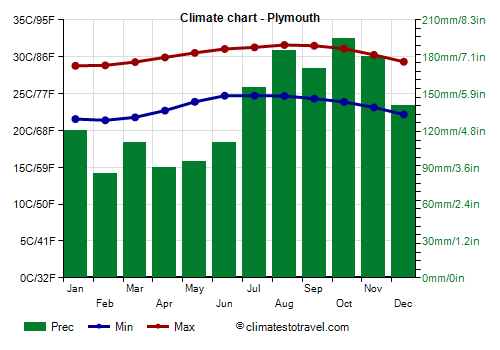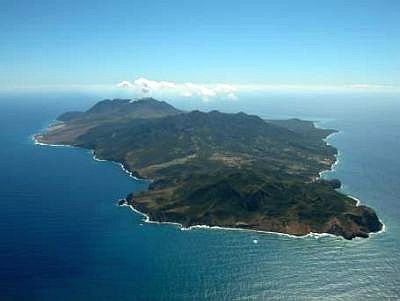Select units of measurement for the temperature and rainfall tables (metric or imperial).
Average weather, temperature, rainfall, sunshine
Montserrat, an island and an overseas territory of the United Kingdom, has a tropical climate,
hot and humid all year round, with a relatively cool and dry season from January to mid-April and a hot, humid and rainy season from mid-June to mid-November.
In the former period, the
northeast trade winds, constant winds typical of tropical climates, blow steadily and with moderate intensity, while in the latter period, these winds are more irregular, and may have some pauses, increasing the feeling of sultriness.
Between them, there are two
transitional periods: from mid November to early January (when the northeast trade winds start to blow, the temperature decreases a bit and the weather gets better) and from mid-April to Mid-June (when both the temperature and the frequency of downpours gradually increase).
The
rains in Montserrat are abundant, and exceed 1,500 millimeters (60 in) per year even on the coast. After the hot and wet period, the sea is still warm enough to provide energy and moisture for the formation of thunderclouds, so the rains are still quite frequent in the first months of the north-east trade winds (from November to January).
The interior of the island is occupied by
hills and low mountains, and is even more rainy. The highest point is
Soufrière Hills, a volcano of 915 meters (3,000 feet). In 1995, the volcano produced a strong
eruption, which devastated the southern part of the island, including Plymouth. The southern part has been declared "exclusion zone", while the northern part is still inhabited and is believed to be protected from volcanic eruptions.
The climate in detail
Temperature and rain
Plymouth

In the old capital,
Plymouth, the average temperature varies between 25 °C (77 °F) in January and February and 28 °C (82.5 °F) from June to September. As you can see, there are little variations between the coolest and the warmest period.
Rainfall in Plymouth amounts to 1,600 millimeters (65 inches) per year, including more than 100 mm (4 in) per month from June to January, and more than 150 mm (6 in) from July to November. The driest month is February, with an average of 85 mm (3.3 in), which means that some showers are possible even in this period.
The rains in Montserrat occur throughout the year especially in the form of
downpours or thunderstorms, which could be intense, but generally do not last long, so they do not reduce too much the sunshine hours; sometimes, however, there may be a more intense wave of bad weather.
In fact, the amount of
sunshine is good all year round, at least along the coasts.
In the northern part, we find both the temporary capital, Brades, and the capital under construction,
Little Bay.

Sea temperature
The
sea in Montserrat is pleasantly warm all year round, in fact the water temperature drops to a minimum of 26.5 °C (79.5 °F) in February and March.
Hurricanes
The greatest danger comes from tropical storms and cyclones, called
hurricanes in the Caribbean area, which may pass over the island from June to November, though they are most likely from August to October. A very violent hurricane that struck Montserrat was Okeechobee in September 1928, and another one was Hugo, which hit the island on September 17, 1989.
When to go
The best time to visit Montserrat is from
February to April, since it's the driest period of the year. In December and January, there are some additional showers, but we are still in the least hot period, so, all in all, they are acceptable months as well.
What to pack
All year round: bring
light clothes of natural fabric, a sun hat, sunscreen, and possibly a light sweatshirt and a light raincoat for thunderstorms. From December to March, you can add a light sweatshirt for the evening.
When going to the reef, you can bring snorkeling equipment, including water shoes or rubber-soled shoes.
Climate data - Montserrat
| Plymouth |
|---|
|
| Jan | Feb | Mar | Apr | May | Jun | Jul | Aug | Sep | Oct | Nov | Dec |
|---|
| Min temp. | 22 | 21 | 22 | 23 | 24 | 25 | 25 | 25 | 24 | 24 | 23 | 22 |
|---|
| Max temp. | 29 | 29 | 29 | 30 | 31 | 31 | 31 | 32 | 31 | 31 | 30 | 29 |
|---|
| Precip. | 120 | 85 | 110 | 90 | 95 | 110 | 155 | 185 | 170 | 195 | 180 | 140 |
|---|
| Prec. days | 12 | 9 | 9 | 8 | 10 | 13 | 14 | 16 | 13 | 14 | 16 | 13 |
|---|
|
| Day length | 11 | 12 | 12 | 12 | 13 | 13 | 13 | 13 | 12 | 12 | 11 | 11 |
|---|
| Sun hours | 8 | 8 | 8 | 8 | 8 | 8 | 8 | 8 | 7 | 7 | 7 | 7 |
|---|
| Sea temp | 27 | 26 | 26 | 27 | 28 | 28 | 28 | 29 | 29 | 29 | 28 | 28 |
|---|